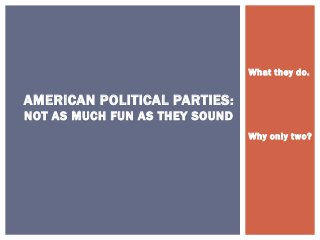
American political parties
- 1. What they do. AMERICAN POLITICAL PARTIES : NOT AS MUCH FUN AS THEY SOUND Why only two?
- 2. WHAT DO PARTIES DO? What is the goal of the two major parties? To win elections Read p. 116 2 nd column: Is this still true? Five Major Functions Nominate Candidates Informing Supporters Bonding Agent Governing Watchdog
- 3. NOMINATING CANDIDATES -- primary responsibility -- presidential nomination is a function of the parties
- 4. INFORMING AND ACTIVATING SUPPORTERS -- campaign for their candidates -- write platforms Are presidential candidates beholden to their party platforms? How do parties “inform” the voters? Advertising, buttons, bumper stickers etc.
- 5. BONDING AGENT -- try to pick good candidates -- try to make victorious candidates govern well Why?
- 6. GOVERNING -- Congress is organized around party
- 7. WATCHDOG -- The party out of power holds the ruling party accountable for their actions. Does this function ever work against the American people?
- 8. WHY ONLY TWO PARTIES? Historical Basis Tradition Electoral System American Ideological Consensus
- 9. HISTORICAL BASIS -- no mention of parties in Constitution -- started with two parties (Federalist and Anti -Federalists
- 10. ELECTORAL SYSTEM -- winner-take-all elections encourage two, moderate parties -- voters view third parties as a “wasted vote” -- dif ficult for third party pres candidates to appear on all ballots -- Gary Johnson (47 states)
- 11. IDEOLOGICAL CONSENSUS -- American politics played within the 40 yard lines -- Both parties are moderate How does the size of the US impact its politics? What is the fundamental dif ference between the two parties?
- 12. MULTI-PARTY SYSTEMS -- Most European democracies are multi -party -- Smaller, more narrow parties -- Provide clear choices -- Parties must form a coalition to govern
- 13. ADVANTAGES & DISADVANTAGES OF MULTI-PART Y SYSTEM ADVANTAGES DISADVANTAGES
- 14. PARTY MEMBERSHIP PATTERNS -- Party membership is voluntary -- Parties try to attract as many people as possible -- Factors influencing party membership: Family Economic Status Major Events Age Residence Level of Education h t t p : / / w w w . s a c b e e . c o m / 2 01 2 / 1 1 / 0 6 / 4 9 6 6 4 31 / 2 01 2 - e l e c t i o n - e x i t - p o l l - s h o w s . h t m l
- 15. WHO’S AT THESE PARTIES? Democrats Republicans